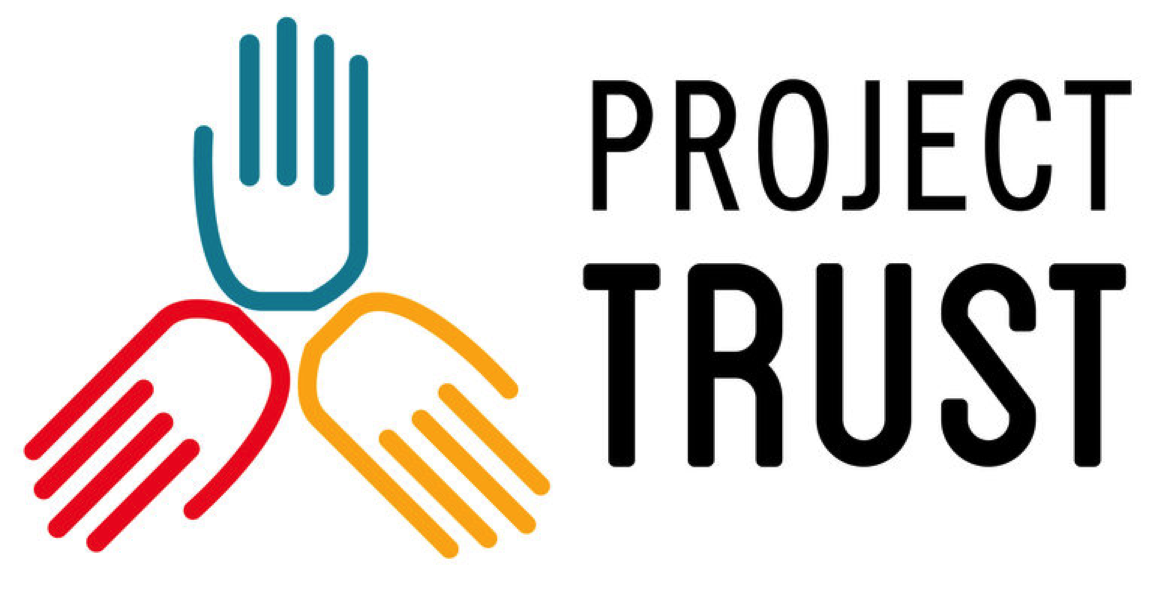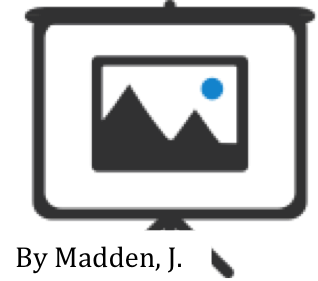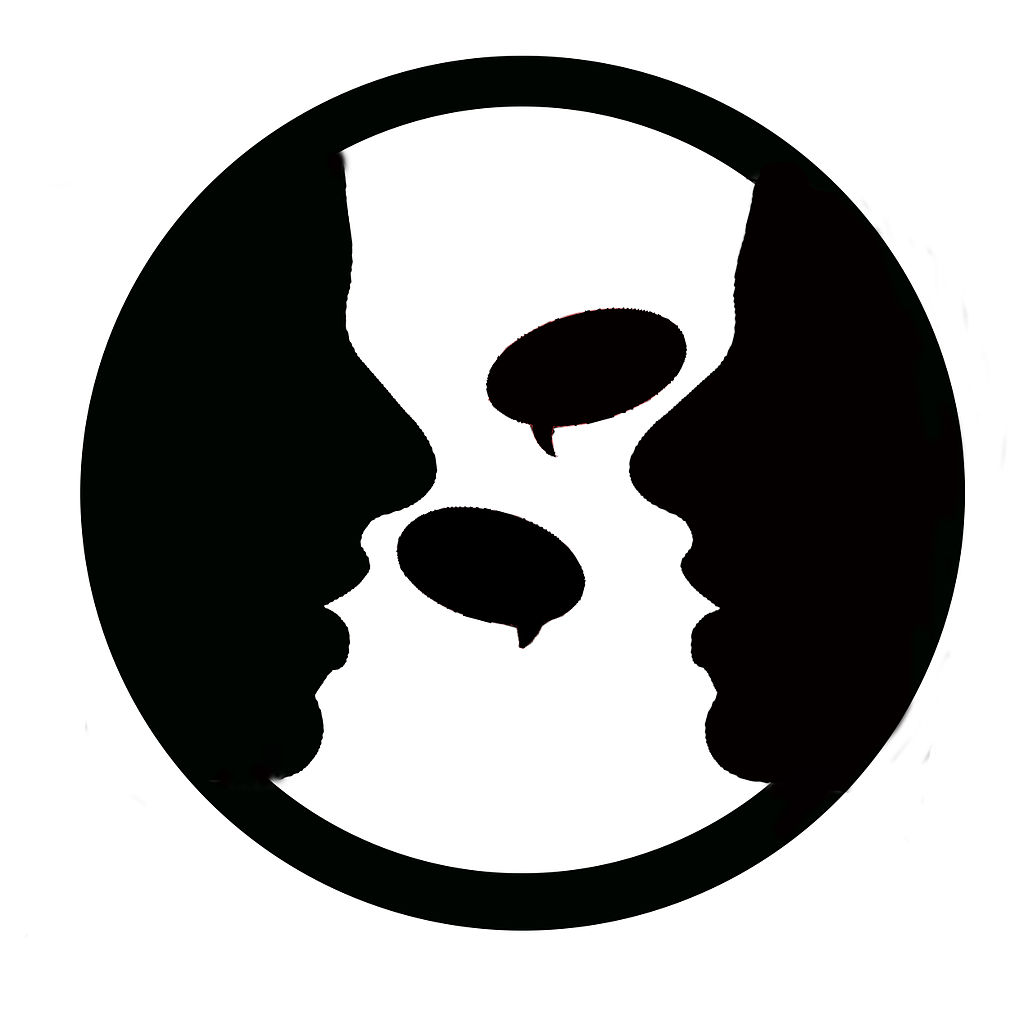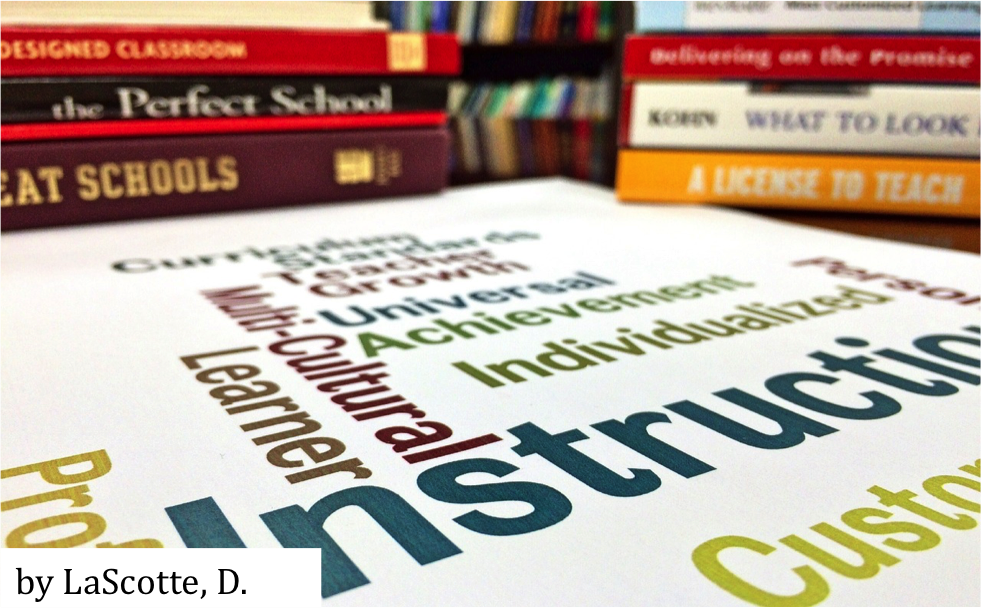This article discusses an approach to supporting resilience in urban students, particularly Somali, Latino, and Hmong youth, through a professional development experience called Project TRUST (Training for Resiliency in Urban Students & Teachers).
“He really connects to the students from experience and from also, he makes
you work hard for your grades. He’s really different from other teachers, or from
past teachers, and like some way this teacher really makes you want to be motivated. Just come to school and like even though you don’t like school, you come to school to be in the classroom, because that’s how great he is.” (Hmong youth)
“… you live in a black and white world and people expect that Latinos can’t do what they can do. Latinos are not going to amount to anything, you know what I mean? Like, they have no respect, I guess? They just assume just because we’re Latino that we’re not going to graduate, that we’re going to get pregnant, that we’re going to gang bang. But those … it doesn’t even have to be like a Latino administrator. Anyone who takes the time to understand another person.” (Latino youth)
“I was new to school and I didn’t know anybody and was too scared to go to class and everything. My science teacher, she really helped me. She showed me around the school. I was scared, but she helped me out a lot even though still a lot of summer school. She just helped me around. Every time I have a problem. She always tells me, ‘Come to me. Don’t feel scared.’” (Somali youth)
These statements came from nearly sixty hours of focus groups and one-on-one interviews with Somali, Latino, and Hmong youth, parents, as well as community youth workers and high school teachers. The goal of these focus groups was to engage youth and adults around such questions as, “What is resilience?”, “How do you know a resilient person when you see one?”, and “How can teachers support resilience in young people?”. Youth and parents from Somali, Latino, and Hmong communities in the Twin Cities shared their experiences, stories, and knowledge with community researchers working on Project TRUST (2014), a community-based participatory research (Macauley, Commanda, Freeman, Gibson, McCabe, Robbins, & Twohig,1999; Wallerstein & Duran, 2010), partnership project1. Specifically, Project TRUST (2014) is a community-university partnership between the Somali, Latino, Hmong (SoLaHmo) Partnership for Health and Wellness, the University of Minnesota Medical School Program in Health Disparities Research, and College of Education and Human Development. Our collaborative board includes teachers, representatives of community organizations, and Somali, Latino, and Hmong parents and youth.
A Community Advisory Board, consisting of community and university members, used a concept mapping model to determine key themes and ranked these in terms of importance and perceived feasibility for enactment in classrooms and schools. Out of this work, Project TRUST (2014) developed an embedded, long-term professional development curriculum that aims to engage high school teachers across content areas in strengthening or developing strategies to deepen the networks of belonging and support that facilitate positive youth development and resilience in all youth, but focusing particularly on Somali, Hmong, and Latino immigrant or heritage youth.
Resilience and Positive Youth Development
Resilience is the ability to cope with, adapt to, and overcome challenges. From the research in positive youth development, youth who are resilient tend to possess a set of internal, family, school, and community developmental assets that they rely on to overcome challenges in or out of school (Bernat & Resnick, 2006; Youngblade, Theokas, Schulenberg, Curry, Huang, & Novak, 2007). More assets make it more likely that youth will do well.
Importantly, research shows that these assets are malleable over time and can be intentionally developed with youth to support their healthy development and academic achievement (Gavin, Catalano, David-Ferdon, Gloppen, & Markha, 2010). Internal assets, such as belief in the future, pro-social behaviors, and interpersonal skills, are typically developed in the context of a relationship with an adult, such as a teacher who models these behaviors, and in environments oriented towards providing youth opportunities to identify and develop their own skills and strengths. Teenagers, then, develop their internal assets within a relationship, which in turn is an asset within a larger positive school environment. This layering on of protection, which may come from a relationship with a single teacher, supports youth in doing well personally and in school.
One important timeframe for promoting resilience is during adolescence. In the early high school years, most youth are in mid-adolescence (ages 14-16). Some characteristics of this developmental stage are that these youth are at the peak of their peer orientation, are concerned about their appearance, and are sensitive to being singled out or treated as different (Erikson, 1968). They are in the process of developing complex thinking and an ability to plan and consider consequences. If harnessed, teachers can use these adolescent development tendencies to their advantage. For example, teachers can create a classroom environment that is a safe place where students are expected to treat their peers with respect. Doing so builds a common in-group community that will feel positive and motivating to students. Additionally, teachers can support youth in developing the asset of planning and decision making by being explicit about the steps necessary to finish a project and giving examples of decisions that may get in the way of completing a project.
Each of us can think back to a time when our own sense of resilience has helped us get through something difficult or to realize we should be going in a different direction. Tapping into resiliency in teaching and learning and pushing students to develop the capacity of being resilient are key to school success and the healthy development of high school aged students. One way to think about resilience is with a focus on what assets the student already has or is developing. Research on resilience shows us that youth who possess internal, family, school and community assets are also likely to have positive health and developmental outcomes over time, despite experiencing challenges such as poverty or discrimination (Bernat & Resnick, 2006; Resnick, Bearman, Blum, Bauman, Harris, Jones, et al.,1997; Youngblade, et al., 2007). One of the most important of these assets for the development of a teenager is that they feel connected to non-parental adults, such as teachers, and to their schools.
This sense of connectedness is associated with both greater educational achievement and lower risky behaviors to their health, such as substance use and risky sexual activity. In addition to all of this, resiliency and academic achievement are intertwined. Studies that look at factors that affect long-term health show us that individual academic achievement is actually a key contributor to wellness and longevity (Reyes, Brackett, Rivers, White, & Salovey, 2012; Youngblade, et al., 2007). Education and long-term health outcomes are so intertwined that, if the United States had made the same investment in addressing educational disparities as we did in developing technology between 1996-2002, we would have achieved eight times greater reduction in mortality (Woolf, Johnson, Phillips, & Philipsen, 2007).
Focusing on Somali, Latino, and Hmong Youth in Urban Schools
For decades, Minnesota’s population has been enriched by waves of transnational and diaspora populations who have settled by choice or necessity. In academic year 2013-2014, Minneapolis Public School District reported having 11,209 students who speak a language or dialect other than English at home (57 different languages and dialects) and St. Paul Public School District reported having 16,975 students who speak a language or dialect other than English at home (112 different languages and dialects) (Minnesota Department of Education, 2015).2 Both the country’s largest Somali community and the country’s second-largest and most concentrated Hmong community call Minnesota home, with more than 30,000 Somali, and 60,000 Hmong-Minnesotans (Hmong American Partnership, 2010; U.S. Census Bureau, 2013b).
The population of Latinos has shown the most growth, in both Minnesota and the country, with the population increasing by 75% in the state between 2009-2013 (U.S. Census Bureau, 2013a). Conservative estimates from 2010 suggest that more than 8% of the K-12 student population in Minnesota can be identified as Hispanic (Pew Research Center, 2011). Such vital and dynamic student and community populations offer both great opportunity and numerous learning curves for educators.
Youth from these communities are minoritized groups in Minnesota school districts. In other words, the languages and cultural practices and knowledge represented in this groups do not tend to be highly privileged in schooling spaces, content, and knowledge production. In addition, they disproportionately experience long-term and academic achievement challenges such as poverty, histories of trauma, and adult role models in schools who have limited experience with students’ languages and cultural backgrounds (Bigelow, 2008; 2010; Lopez, 2003; Ngo, 2008; Ngo, Bigelow, & Wahlstrom, 2007). How can schools and teachers maximize the assets and networks of resilience that thrive in these communities to support Somali, Latino, and Hmong youth to navigate school successfully and to build assets towards positive youth development? This question has been the driving force behind the work undertaken by Project TRUST (2014). We are often asked, “Why focus on Somali, Latino, and Hmong youth?”
What is Project TRUST?
Project TRUST (2014) is not only a professional development opportunity, it is also a research study. Project TRUST (2014) is a National Institutes of Health funded, community based participatory research project that aims to support educators in engaging with all students, but with Somali, Latino, and Hmong students in particular, in ways that contribute to academic achievement and positive youth development. The project goal is to develop and pilot an educator professional development program that connects teachers with the knowledge gathered from youth and parents in the Somali, Latino, and Hmong communities. Finding ways to increase Somali, Latino, and Hmong students’ connections to school and teachers can make a big difference. Many teachers taking part in the initial pilots have reported benefits with students who do not identify as Somali, Latino, and Hmong as well, and particularly with students of color. The goal is to support educators as they develop and strengthen approaches, skills, and strategies for interacting with their students in ways that promote resiliency, facilitate effective learning environments, and increase student engagement and connectedness to their teachers and school.
Gaining Perspective from Community Members
The Project TRUST (2014) team spent three years gathering perspectives from teachers; administrators; youth-workers with particular expertise working with Somali, Latino, and Hmong youth; and parents and youth themselves on how educators can best promote resilience in the classroom (Allen, Ortega, Rosas-Lee, Pergament, Hang, & Omar, under review). Somali, Latino, and Hmong community researchers utilized an innovative concept mapping approach (Allen, Shaleben-Boateng, Davey, Hang, & Pergament, forthcoming) wherein community members from our collaborative board identified key perspectives from the qualitative data and ranked those ideas on importance and feasibility.
In so doing, Project TRUST (2014) attempted to shift the eye of analysis and meaning making away from external researchers in the academy and into the hands of community members themselves. Over the last year, teachers, administrators, youth, parents, and other community members have worked together to translate these priorities and evidence-based resilience-promotion strategies into the Project TRUST (2014) curriculum for teachers, in a way that aligns with the work already happening in schools.
Key Facets of Professional Development for Project TRUST
A decision we made early on in the project was that we would focus the curriculum on tools that the teachers could use and skills they could develop to build resilience. The approach would be assets-focused with regard to our stance toward both teachers and students. In addition, we made a commitment to focusing on supporting teachers in doing inquiry and taking action into classroom practices and interactions with their students. In addition to these values, we knew that for the professional development to serve teachers well, it needed to be long-term, embedded in professional development structures already established in the school (i.e., Professional Learning Communities), and embedded in teachers’ practice. Project TRUST (2014) had to focus on teachers’ day-to-day work and not be something extra that was unrelated to their teaching. It also needed to include many layers of personalization, such as dilemma processing, dialogue with colleagues, and inquiry and action in one’s own practice.
Project TRUST (2014) pilot-tested the first version of the professional development curriculum for teachers. In this early stage, we surveyed teachers after each session and took field notes about how the sessions unfolded – how the facilitation went, and how the teachers engaged with the material. In this first iteration of the project, we discovered a number of ways to improve the curriculum. These included rearranging the order of session topics, providing improved access to academic research that connected to the existing topics, and building in additional time and space for teachers to connect research and community voices to their own teaching practices and dilemmas. A key aspect of the experience was a pedagogy of reflection, dialogue and inquiry. In this professional development experience, teachers read, discuss, and implement tools for building resilience in their own practice.
Now, in the second stage of Project TRUST (2014), we are offering the professional development to more teachers, with nearly 70 teachers and educational support staff (including school social workers) taking part. These educators span all content areas, and include teachers of English as an Additional Language, world languages, special education, family and consumer sciences, health and physical education, and art. In the next stage of the project we plan to expand our current work to more sites and to determine the effectiveness of the professional development with a larger group of teachers and students over a longer period of time. The constructivist and action-oriented nature of the professional development that we used in the first pilot continued in this second iteration.
What are the sessions like? Project TRUST (2014) Topics and Tools
Following are the current nine topics in the professional development series.
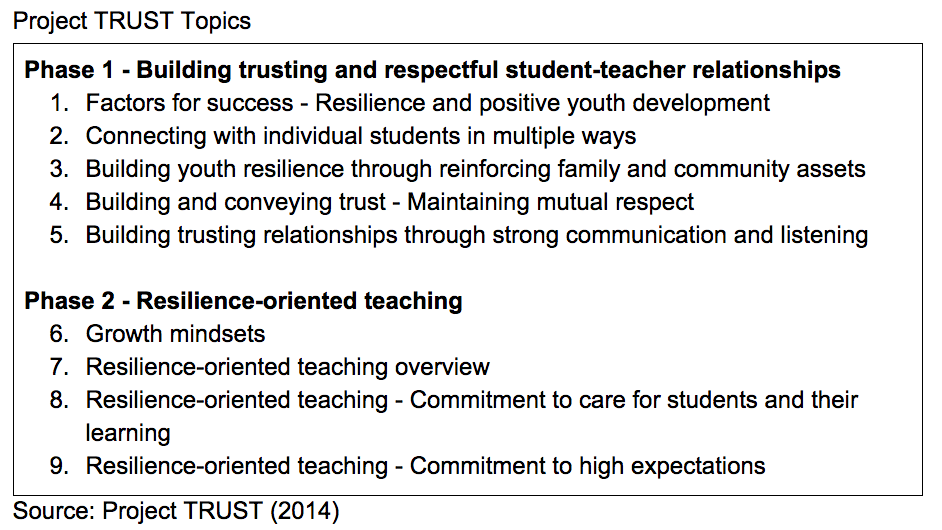
The nine sessions are designed for use within existing professional learning communities (PLCs). In the pilot year, Project TRUST (2014) facilitated sessions occurred every other week. Between sessions, teachers explored their own practice and utilized the strategies and ideas discussed in the previous session. Participating teachers also used this time to access background materials, including youth and parent quotes and summaries of connected research on classroom practice. Each session included a “Tool for Use/Inquiry” to guide participants through a process of inquiry on their classroom practices and their relationships with focal students of their choosing. At the beginning of the following session, teachers then checked-in with fellow colleagues in the PLC to share what they had done, reflected on the experience, and processed dilemmas that arose.
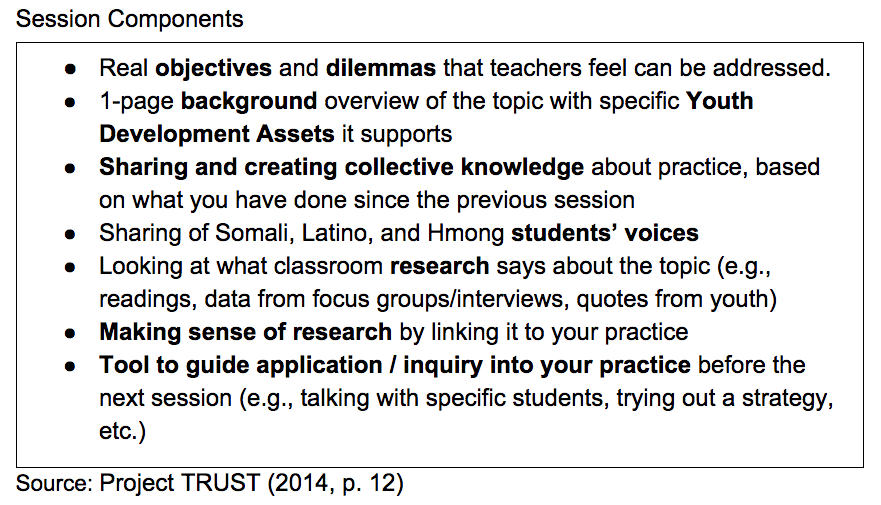
Each session focused on engaging participating teachers in professional conversations with colleagues around inquiry into teaching practices, making sense of research and what it means for teaching and learning in different classrooms, and reading and listening to quotes shared by Somali, Latino, and Hmong youth and parents. Each session included the steps in Figure 2, all designed to support connections between research and practice.
An example of one of these Tools for Use / Inquiry can be seen in Figure 3. This tool followed our seventh session, during which we introduced and explored the concept of resiliency-oriented teaching. This session linked Project TRUST’s (2014) “resiliency-oriented teaching” to existing conceptualizations in education of warm demanders (Delpit, 1995) and positive youth development of authoritative parenting (Baumrind, 1967; Maccoby & Martin, 1983).
During this session, the group members collectively connected stories of their own classroom practices and dilemmas with these existing paradigms. As a group, the teachers discussed how any teacher could be (or could be perceived to be as) authoritarian, permissive, resiliency-oriented, and disengaged with different students across a day, or a class period. Teachers agreed that they recognized they were engaging in different styles at different times and with different students. Importantly, teachers expressed discomfort and displeasure when they found themselves engaging in practices that were not resiliency-oriented. Teachers often expressed feeling like they were “pushed” or simply “out of ideas” and “at the end of [their] rope.”

Over the next two weeks, PLC members used this tool to guide independent inquiry into their classroom practices and interactions with students. The tool asked them to focus on a single class or group of students and to be mindful of what contextualizes their shifting practices. What is the context? Which students are experiencing them as this style of teacher? What seems to trigger this style of teaching? What about their practice or interaction makes them think it is this style? What are their students doing or saying that indicates to them they are or are not in the resiliency-teaching “zone”? It is important to note that the session asked teachers to identify different teaching styles as well as to consider how these styles influence relationships with students. In other words, which students are repeatedly experiencing any given teaching style with them? Many teachers felt this eye on the patterns of teaching styles was useful to help them intentionally key in on and interrogate the practices that were not facilitating resiliency-oriented learning in their classrooms. At the beginning of the following session, teachers brought dilemmas and stories of success with them back to the PLC and used these to engage in collective knowledge sharing and building with their colleagues.
Final Thoughts: The answers aren’t in the back of the book – they are in us
While we can not eliminate all education disparities with just one approach, we do know that generating strong connections between youth, teachers, other educators, and adult role models in a young person’s day can have a huge impact. Students interviewed by Project TRUST (2014) researchers reported learning a lot from their teachers’ stories about consequences. They enjoyed hearing about how their teachers made poor decisions and suffered the consequences but ended up doing well in the long-run – just like the students said they do. Beyond that, they learned through the stories which teachers shared about how they had navigated challenges, who had helped them, and what strengths they had developed from that experience that they continue to use. These networks of resilience, and the ways struggles develop strengths, were powerful moments of connection, teaching, and learning.
References
Allen, M.L., Ortega, L.E., Rosas-Lee, M., Pergament, S., Hang, M., & Omar, L. (under review). Promoting positive youth development in high school for Somali, Latino, and Hmong youth: Perspectives of teachers, youth-workers, and students. Journal of Primary Prevention.
Allen, M. L., Shaleben-Boateng, D., Davey, C., Hang, M., & Pergament, S. (forthcoming). Concept mapping as an approach to facilitate participatory intervention building. Progress in Community Health Partnership.
Baumrind, D. (1967). Child care practices anteceding three patterns of preschool behavior. Genetic Psychology Monographs, 75(1), 43-88.
Bernat, D. H., & Resnick, M. D. (2006). Healthy youth development: Science and strategies. Journal of Public Health Management and Practice, 12, S10-S16.
Bigelow, M. (2010). Mogadishu on the Mississippi: Language, racialized identity, and education in a new land. New York: Wiley-Blackwell.
Bigelow, M. (2008). Somali adolescents’ negotiation of religious and racial bias in and out of school. Theory into Practice, 47(1), 27-34.
Delpit, L. (1995). Other people’s children. The New Press.
Erikson, E. H. (1968). Identity: Youth and crisis. New York: Norton & Co.
Gavin, L. E., Catalano, R. F., David-Ferdon, C., Gloppen, K. M., & Markham, C. M. (2010). A review of positive youth development programs that promote adolescent sexual and reproductive health. Journal of Adolescent Health, 46(3), S75-S91.
Hmong American Partnership (2010). 2010 Census Hmong Population by State. Retrieved from http://www.hmong.org/page33422626.aspx.
Lopez, N. (2003). Hopeful girls, troubled boys: Race and gender disparity in urban education. New York: Routledge.
Macauley, A.C., Commanda, L.E., Freeman, W.L., Gibson, N., McCabe, M.L., Robbins, C.M., & Twohig, P.L. (1999). Participatory research maximises community and lay involvement. British Medical Journal, 319, 774 -778.
Maccoby, E., & Martin, J. (1983). Parent-child relationships. In P. Mussen (Series Ed.), and E.M. Hetherington (Vol. Ed.) Handbook of child psychology. Vol. 4. Socialization, personality and social development (pp. 1-101). New York: Wiley.
Minnesota Department of Education. Data Reports and Analytics. Retrieved from http://w20.education.state.mn.us/MDEAnalytics/Data.jsp on February 4, 2015.
Ngo, B. (2008). The affective consequences of cultural capital: Feelings of powerlessness, gratitude, and faith among Hmong refugee parents. Journal of Southeast Asian American Education and Advancement, 3. Retrieved from http://jsaaea.coehd.utsa.edu/index.php/JSAAEA
Ngo, B., Bigelow, M., & Wahlstrom, K. (2007). The transition of Wat Tham Krabok Hmong children to Saint Paul Public Schools: Perspectives of teachers, principals, and Hmong parents. Hmong Studies Journal, 8, 1-36.
Pew Research Center. (2011). Demographic profile of Hispanics in Minnesota. Retrieved from http://www.pewhispanic.org/states/state/mn/.
Project TRUST. (2014, September). Building resiliency with a focus on Somali, Latino, and Hmong students: Professional development curriculum. [A community partnership between SoLaHmo Partnership for Health and Wellness, Westside Community Health
Services; College of Education and Human Development, and University of Minnesota Medical School Program in Health Disparities Research, University of Minnesota; and St. Paul Public Schools].
Resnick, M. D., Bearman, P. S., Blum, R. W., Bauman, K. E., Harris, K. M., Jones, J., … Udry, J. R. (1997). Protecting adolescents from harm. Findings from the National Longitudinal Study on Adolescent Health. JAMA, 278(10), 823-832.
Reyes, M. R., Brackett, M. A., Rivers, S. E., White, M., & Salovey, P. (2012). Classroom Emotional Climate, Student Engagement, and Academic Achievement. Journal of Educational Psychology, 104(3), 700-712.
U.S. Census Bureau. (2013a). Minnesota Population Records, 2009-2013 American Community Survey 5-year estimates. Retrieved from http://factfinder.census.gov/faces/tableservices/jsf/pages/productview.xhtml?pid=ACS_pums_csv_2009_2013&prodType=document.
U.S. Census Bureau. (2013b). Total ancestry categories tallied for people with one or more ancestry categories reported, 2008-2012 American Community Survey 5-year estimates. Retrieved from http://factfinder.census.gov/faces/tableservices/jsf/pages/productview.xhtml?src=bkmk.
Wallerstein, N. & Duran, B. (2010). Community-based participatory research contributions to intervention research: The intersection of science and practice to improve health equity. American Journal of Public Health, 100(1), S40-S46.
Woolf, S.H., Johnson, R.E., Phillips, R.L., & Philipsen, M. (2007). Giving everyone the health of the educated: An examination of whether social change would save more lives than medial advances. American Journal of Public Health, 97(4), 679-683.
Youngblade, L. M., Theokas, C., Schulenberg, J., Curry, L., Huang, I. C., & Novak, M. (2007). Risk and promotive factors in families, schools, and communities: A contextual model of positive youth development in adolescence. Pediatrics, 119(Supplement 1), S47-S53.
1Research reported in this publication was supported by National Institute of Minority Health and Health Disparities of the National Institutes of Health under award number R24MD007966. The content is solely the responsibility of the authors and does not necessarily represent the official views of the National Institutes of Health. Additional funding came from the University of Minnesota Clinical Translational Science Institute Planning Grant # CTSI 15673, and the University of Minnesota Program in Health Disparities Research Planning Grant # 2010-004.
2These data are not exact because of how dialects and languages are (mis)categorized by district personnel and/or because families may not always name their particular home language but rather the larger language family under which their language falls. For example, speakers of Pa’o, Pwo, Kayan, Lahta, Geba, Gekho, and Paku may all name their home language as Karen. Disagreements about what is a language and what is a dialect are common among speakers and sociolinguists.

